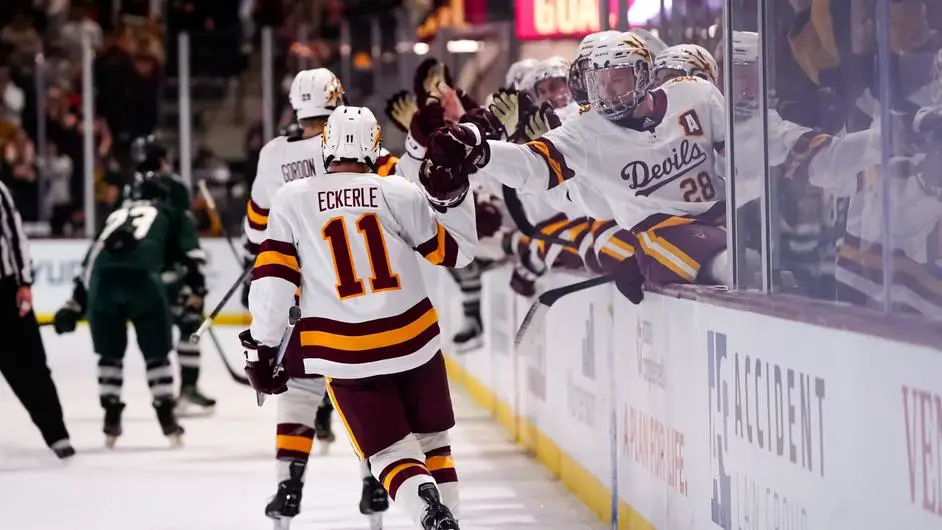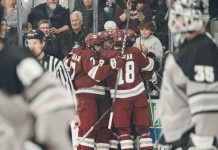
Each week during the season, we look at the big events and big games around Division I men’s college hockey in Tuesday Morning Quarterback.
Jim: Well, Ed, we are let’s say about 95% through the first part of the season and most schools have begun their holiday exam break.
I guess at this point, we should discuss what we have learned that this point in the season. I will begin in the conferences. The NCHC, Big Ten and Hockey East are pretty much running away in non-conference play. All three have winning percentages significantly above .600.
But that unfortunately leaves three other conferences and a group of independents that are all below .400 winning percentages. Among that only Quinnipiac and RIT are in the top 16 of the current PairWise. No one in the CCHA is even close to the bubble, an unfamiliar place for that league.
Take this wherever you want – the positive of the top of the crop or the negatives of those struggling to this point. But what stands out to you?
Ed: Jim, this very thing has left me wondering whether we’re seeing a blip or an anomaly here, or whether things are going to split more permanently into haves and have-nots.
At the Frozen Four in Tampa last April, the buzz was around whether the Big Ten would end up dominating in an era of NIL and whatever else may lie ahead in NCAA changes. As of today, there are four teams from that conference inside the bubble, but Michigan at No. 15 would be bumped by an autobid. The highest team of four from the NCHC is North Dakota at No. 5, but St. Cloud State at No. 14 would be in a precarious spot, too.
Hockey East is the conference that I’m interested in. What really stands out to me is the ascent this season of Maine and New Hampshire. That has given the league a boost, and right now five teams are at No. 12 or above, all safe spots at the end of the season. However, six Hockey East teams were in the top 16 at around this time last year, yet only Boston University and Merrimack made it to the NCAA tournament.
There’s still room for teams from ECAC, CCHA, and Atlantic Hockey to squeeze in, but it will take a real run in conference to get there. Cornell and Minnesota State are within a stone’s throw. RIT has four nonconference matchups, including a Dec. 29 date with Maine at the Ledyard Bank Classic, to improve its chances.
That leaves the independents, especially Arizona State and Alaska. The Sun Devils weren’t helped by the pair of ties with Dartmouth. They and the Nanooks will need to put together a great run with little room for error to make it in. What’s the outlook for these two indies?
Jim: Our good friend and Robert Morris coach Derek Schooley went out on a limb more than a month ago on our Weekend Review Podcast saying that he didn’t believe an independent would make the NCAA tournament this season.
I think some of his reasoning related to Arizona State and its massively home-heavy schedule. Because the Sun Devils play 70% of their games at home, most wins will only be worth 80% of a win in the PairWise, something that coach Greg Powers was aware of when he made this schedule.
Certainly, Mullett Arena is a massive home-ice advantage for the Sun Devils, and they will win a lot of games there. But then you run across a weekend like this past one where ASU tied a decent Dartmouth team twice. At the end of the weekend, two home ties equated to 80% of one win against an ECAC opponents, which negatively impacted their PairWise.
That’s why I feel like I can be more bullish that Alaska would be the independent team to grab an NCAA at-large bid this season. It’s still a long road ahead for the Nanooks and they need to win games over the next 45 days or so to place the team in a good PairWise position. But there will be more chances to earn the bonus for road wins for Alaska than Arizona State.
I answered your question, I think. But was that too much math for you (and our faithful readers) to handle?
Ed: I guess we’re forced to do a bit of math because of how the PairWise – and particularly the RPI – works. The massaging of the formula over the years introduced home-away-neutral multipliers, evolving overtime win-loss ratios, quality win bonuses, and other arithmetic that has made it the job of algorithms to pick teams. It’s objective, but for many fans also a bit obtuse. However, the merits of the methodology are a discussion for another time.
You and I talked about something with Dan Rubin on the USCHO Edge podcast the other day, and that’s our sense that there’s been a lot of scoring this year. Just look at Denver’s last two weekends as an example.
With my curiosity piqued, I dug into our database of games and found that this season is on pace to be the highest scoring in the past decade. I didn’t go back any further, but I could go back 27 seasons to when USCHO started if I get bored.
Taking the combined goals of both teams of every D-I game for each season, the lowest in the past 10 seasons was 2014-15, with an average of 5.41 goals per game. The average of the nine seasons preceding this one is 5.62. But so far this year, the average in D-I men’s hockey is 5.92 goals per game! Out of 518 games played, 42 of them have had 10 goals or more combined.
So our hunch is correct. (And I know some of our more astute mathematician-hockey-fans will point out all kinds of other things we could quantify. But I’m on deadline here.)
Let’s consider today’s game of college hockey and get a little subjective perhaps. Why do you think we’re seeing scoring up by more than five percent over the 10-year average and nearly 10 percent over 10 seasons ago?
Jim: That’s excellent research into the numbers and I am glad that our hunches were headed in the right direction.
All that said, I do have a hunch on the reason or reasons behind it. I think there are multiple levels to the added offense.
Let’s go back to a decade or so ago when we were at a low in goal production. That was the peak of the goaltender equipment advancements. The technology hasn’t improved too much since then but one area of the game has: video.
Players and coaches have had more time to study tendencies – of defenses, of goaltenders, of penalty kills. Sure, video has been part of this game for more than four decades. But the ability to splice clips and distribute to players in a quick and easy manner continues to increase and improve. You also have players always attempting to replicate what they see on “SportsCenter Top 10” every night.
Long explanation short, players are spending more time than ever trying to figure out ways to score and it is paying off.
The question, though, is how long this offense lasts. Will we see NCAA games with 10+ goals like we did a year ago or will defenses improve and more games are right checking and low scoring like we typically see in the Frozen Four. Last year’s final had five goals and the year before had six. Right around the average, I guess, but any chance we see an 8-7 game like we did back in 1991 when Northern Michigan beat Boston University?
Ed: I don’t know about 8-7, but I could see us getting close to double digits.
Let’s take the scenario of a hypothetical Denver-Michigan State final, which is certainly not out of the realm of possibility. If the tendencies those teams have had so far carry throughout the rest of the season, you’d have Denver’s No. 1 offense (5.22 goals per game) and the No. 45 defense (3.22 GPG) vs. Sparty’s No. 3 offense (4.22 GPG) and No. 38 defense (3.11 GPG).
That could be a lot of fun.
Jim, I agree with all of your reasons for the uptick in scoring.
Maybe goaltenders and goalie coaches could stem the tide a bit more if they cut down on those top-corner pucks whizzing past their ears when in the RVH?
No numbers on my part for that one. Just another hunch.


